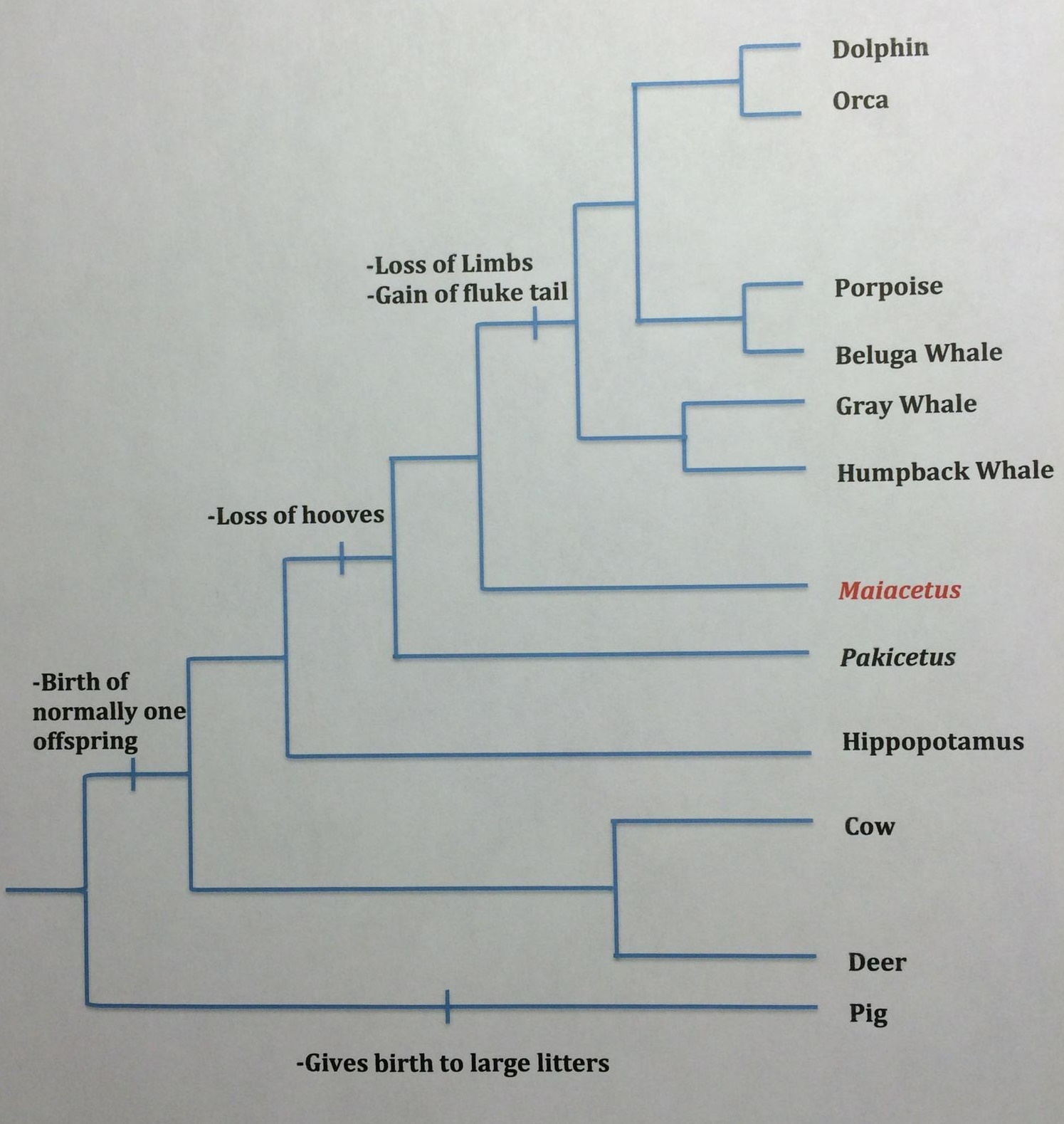Classification
Domain: Eukarya
· Members of this domain are organisms made up of cells
containing a nucleus and membrane bound organelles.
Kingdom: Animalia
· All members are multicellular, and heterotrophs. Animal
bodies are made up of cells that are organized into tissues. Each
tissue within the animal is specialized to help perform specific
tasks.
Phylum: Chordata
· Animals within this phylum have a dorsal nerve chord, a
notochord, pharyngeal gill slits and a muscular tail that extends
beyond their anus sometime during development.
Class: Mammalia
· This class is extremely diverse and advanced. Mammals are
endothermic and have a high rate metabolism. Organisms in this class also have
mammary glands and hair that separate them from reptiles and birds.
Order: Cetacea
· This order includes marine animals like, whales, dolphins,
and porpoises. The Maiacetus inuus fits into this order because they
are a precursor to the modern whale.
Family: Protocetidae
· This family is a diverse and heterogeneous group of cetaceans
known from Asia, Europe, Africa and North America (Gingerich 2011). They had large
fore and hind limbs that could support the body on land, but also
swim in the water (Gingerich et al. 2009). The organisms were amphibious like the Maiacetus
inuus.
Genus: Maiacetus
· The genus Maiacetus only contains the species Maiacetus
inuus. First described in 2009 based off of two skeletons. It
received the name Maiacetus because this was the first
archaeocete to be discovered with a well developed fetus inside
(Gingerich et al. 2009).
Species: inuus
· This is the only species in genus Maiacetus.
The Maiacetus inuus, also know as the Good Mother
Whale, was primarily named for having a near term fetus. In Greek
-ketos means whale and mia- means mother
(Gingerich et al. 2009). The first Maiacetus
inuus skeleton found was the female, this influenced the genus name.
Inuus is Latin for God of Fecundity. The species name acknowledges the great discovery of the female and fetus fossil in exceptional condition. The discovery of this organism was important in the cetacean fossil record and life history of mammalian evolution (Gingerich et al. 2009).
When
looking at the phylogenetic tree above the Hippopotamus is the
closest living relative of the whale, but is not an ancestor. Both
organisms are large and aquatic, however these traits evolved
separately through convergent evolution from terrestrial ancestors
(Berkley 2014). Researchers believe that whales evolved before hippos
50 million years ago (Berkley 2014).
The early whale ancestor Pakicetus, is assumed to have spent most of its time on land. Later whale ancestors, Ambulocetus, Kutchicetus and Maiacetus, have builds that suggest they lived in more of an aquatic environment. These three organisms helped make the transition from land to sea. They all had shorter legs with enlarged hands and feet to help paddle in the water (Berkley 2014). This build allowed them to live in both environments. As evolution continued after the Maiacetus the whale ancestors began to lose their paddle-like feet and developed a fluked tail. For more information on whale evolution see http://evolution.berkeley.edu/evolibrary/article/evograms_03.
Take a moment and explore other websites on MultipleOranisms.net. Check out organisms such as, the Orca Whale, the Beluga Whale, the Long-Finned Pilot Whale, and the Blue Whale. All four of these whales belong to the order Cetacea along with Maiacetus. Dolphins are also categorized in the same order as the Maiacetus and modern whales. Take a minute to look at the websites past students created on dolphins such as the Spinner Dolphin, the Bottlenose Dolphin, and the Atlantic Spotted Dolphin.
In the second phylogenetic tree (above) you can see that Maiacetus is a sister group to not only other modern whales, but the porpoise, orca, and dolphin as well. The sister group to these is the Pakicetus, which was a precursor to modern whales. The unusual sister group to those is the hippopotamus. Closely followed by that are the cow and the deer. The most distant relative is the pig. Oddly a synapamorphy of the pig is that it gives birth to large litters; whereas every other organism in the tree normally gives birth to one offspring. By clicking on these underlined sister groups you can find more in depth information about these organisms. To learn more about this phylogenetic tree, please visit http://www.oceanlink.info/wot/ancestry.html.
To learn more about our organism, head over to our Habitat and Geography page.

